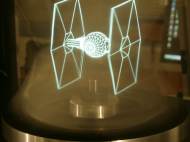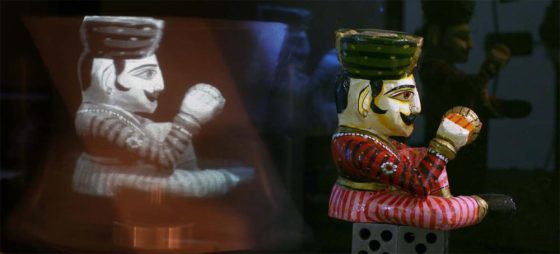An interactive 3D and 360º light field display
 The Graphics Lab at the University of Southern California has designed an easily reproducible, low-cost 3D display system with a form factor that offers a number of advantages for displaying 3D objects in 3D. The display requires no special viewing glasses and generates simultaneous views accommodating large numbers of viewers. The same display was used in order to demonstrate teleconferencing with usage of 3D display (that system will be described in one of our future articles). In this article we’re describing the 3D display system itself.
The Graphics Lab at the University of Southern California has designed an easily reproducible, low-cost 3D display system with a form factor that offers a number of advantages for displaying 3D objects in 3D. The display requires no special viewing glasses and generates simultaneous views accommodating large numbers of viewers. The same display was used in order to demonstrate teleconferencing with usage of 3D display (that system will be described in one of our future articles). In this article we’re describing the 3D display system itself.
The system works by projecting high-speed video onto a rapidly spinning mirror. As the mirror turns, it reflects a different and accurate image to each potential viewer. The rendering algorithm can recreate both virtual and real scenes with correct occlusion, horizontal and vertical perspective, and shading. The display consists of a high-speed video projector, a spinning mirror covered by a holographic diffuser, and FPGA circuitry to decode specially rendered DVI video signals. The display uses a standard programmable graphics card to render over 5,000 images per second of interactive 3D graphics, projecting 360-degree views with 1.25 degree separation up to 20 updates per second.
The projection technique allows correct vertical perspective and parallax to be rendered for any height and distance when these parameters are known. To achieve high speed video projection the modified projector decodes a standard DVI signal from the graphics card. Instead of rendering a color image, the projector takes each 24-bit color frame of video and displays each bit sequentially as separate frames. Thus, if the incoming digital video signal is 60Hz, the projector displays 60×24 = 1,440 frames per second. To achieve faster rates, the video card’s output is set to rates of 200Hz and above (at that frequency the projector displays 4,800 binary frames per second).
Previous volumetric displays used a spinning diffuse plane to scatter light in all directions but could not recreate view-dependent effects such as occlusion. Instead, they used an anisotropic holographic diffuser bonded onto a first surface mirror. Horizontally, the mirror is sharply specular to maintain a 1.25 degree separation between views. Vertically, the mirror scatters widely so the projected image can be viewed from multiple heights.
In order to make better quality images they’ve developed an improved rendering algorithm that generates correct horizontal and vertical perspective at multiple heights. Instead of using a simple perspective camera, they traced each reflected projector ray to find the correct viewer positions at a given moment in time. The system also makes an unique real-time update in order to dynamically adjust the imagery based on each viewer’s height and distance. This is a novel and promising way of displaying 3D imagery.










Leave your response!